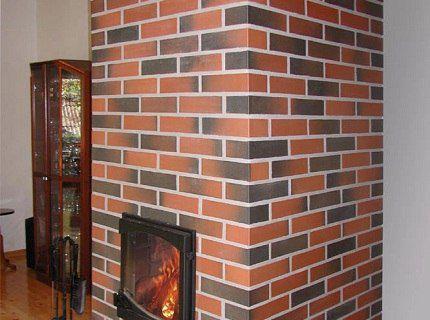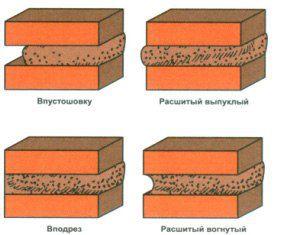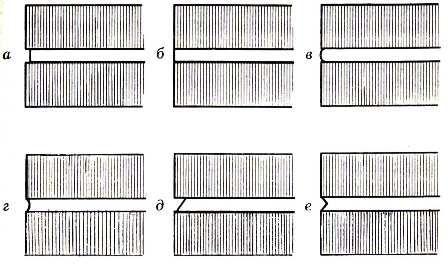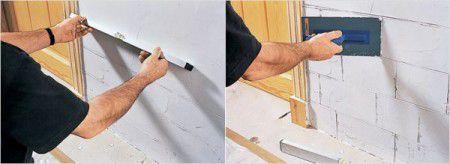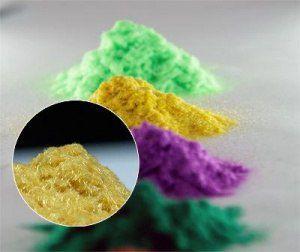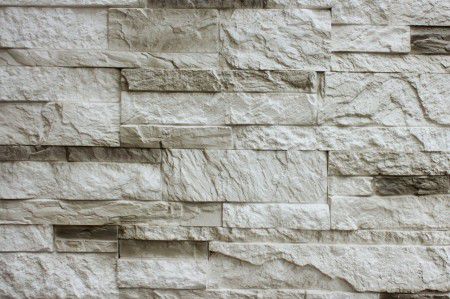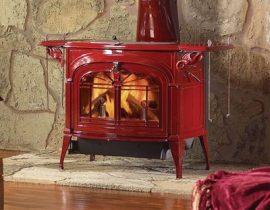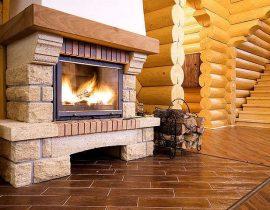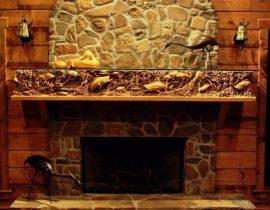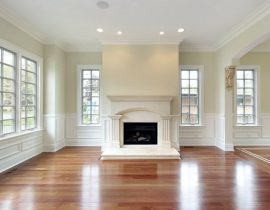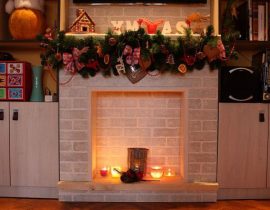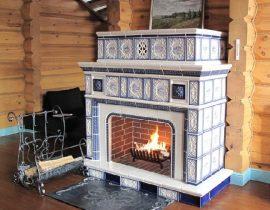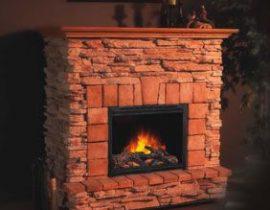The fireplace in a modern interior is not so much the function of heating the room as aesthetic and decorative. At the same time, the type of fireplace is absolutely not important - whether it is wood-burning in a country house or a small false fireplace in a city apartment.
Each of them is a highlight and requires a special design. In order to beautifully revet the fireplace, you do not need to call the masters and pay a lot of money. Even with a small amount of free time, you can create a real masterpiece with your own hands, while working only a couple of hours in the evenings, after the main work.
Content
First look at the fireplace, what would you change?
If the fireplace is brick, they often produce jointing. To do this, a figured tool distributes the mortar that has not yet dried between the bricks. The seams can be depressed or convex, recessed or single-cut.
When laying a fireplace, thin wooden slats are placed between the bricks, which are subsequently removed, and the resulting space is filled with a solution with color pigments (for convenience, a plastic bag is filled with a solution and a corner is cut off).The horizontal seams are processed first, followed by the vertical ones. When the solution dries, it is cleaned with a whisk made of natural materials. Wire bristled brushes are too coarse for this. Often, brickwork is coated with glossy varnish or matte, for this, diluting the varnish with turpentine (one to one).
Brick painting with heat-resistant silicone paints
In an interior dominated by a lot of wood products, a fireplace painted with heat-resistant paints looks great, and besides, this is the easiest cladding method that you can do yourself. A very convenient form of release of such paints is an aerosol. Apply it in several thin layers, each after the previous has dried. It is worth remembering that paints can lie on a brick inhomogeneously.
Do-it-yourself stone fireplace decoration: video from start to finish
Fireplaces, lined natural stone (talc chloride, shell rock and others) look attractive and noble, and the process itself is not too complicated.
Step-by-step process of facing a brick fireplace:
- We prepare the surface
We clean the brickwork from dirt and dust, then deepen the seams by one centimeter. After that, the entire fireplace must be covered with a reinforcing mesh with a cell size of approximately 5x5 cm.
- We lay out the stones on a flat surface (as they will be laid out on the fireplace). For convenience, it is advisable to number the stones with chalk.
- We dilute the cement heat-resistant adhesive (or heat-resistant tile adhesive) according to the instructions.
- With a notched trowel, apply a small amount of glue to the surface of the fireplace. You need to start from the bottom corners.The first two rows will run vertically on the sides from the bottom up. The subsequent rows are laid out horizontally, from top to bottom. Each stone is slightly sunk into the solution and tapped with a rubber mallet. It is important to maintain approximately the same thickness of the seams. There are special plastic crosses for this.
- The final part of the work is removing glue from the front of the stones, grouting and applying varnish.
Used for finishing fake diamond (granite, marble and others). It looks very nice, but the work is painstaking. The cladding process is similar to natural stone cladding, but artificial stones additionally require more accuracy due to their high cost.
Fireplace cladding with ceramic tiles
Ceramic tiles are very often used for facing the fireplace, but it is worth noting that in this case a specific tile with special thermal properties is used, we recommend that you choose one of the following:
- majolica (pressed, glazed ceramic tiles with a pattern);
- terracotta (distinguished by the absence of glaze);
- clinker (such a fairly thick tile is made of clay with a variety of inclusions and additives);
- porcelain stoneware (imitation of natural stone).
Laying process:
- We prepare the surface by cleaning it from dust.
- We fix the reinforcing mesh using nails with metal washers.
- The adhesive solution (preferably heat-resistant) is diluted and applied over the reinforcing mesh using a spatula.
- We make markings using plumb lines (nuts suspended on threads).
- Start laying tiles from the bottom. We apply a small amount of glue and apply the tile. We tap each mallet. To maintain the distance between the tiles, we use crosses.
- The next day after laying, we grout the joints.
It is important to remove excess adhesive mass from the front side of the tiles immediately, without waiting for drying.
We check the correctness of the masonry with a building level.
Plaster
In the case when the brickwork is not ideal, another inexpensive and uncomplicated cladding method is used - plaster. You can start finishing work as soon as the cement mortar between the bricks dries.
Solution preparation
Measure and mix the following ingredients together:
- building plaster - 1 part;
- lime dough - 2 parts;
- fine sand - 1 part;
- asbestos chips - 0.1 parts.
After mixing, for every 10 liters of the mixture, add 200 grams of carpentry liquid glue.
Plastering process
Bumps must be removed from all surfaces of the fireplace. Then we heat the fireplace and begin to wet the bricks with water. For the first layer, we dilute the solution with a more liquid one, approximately like thin sour cream. We apply the plaster with a large soft brush and wait until it dries. For the second layer, the plaster is diluted much thicker. This layer is the final one. Its thickness can reach up to five centimeters. Maximum smoothness is achieved with a trowel, grater, burlap and coarse-grained sandpaper. If necessary, slightly moisten the plaster with water. To achieve the accuracy of the corners, we use wooden slats, which we remove after completion of work.
When the plaster is completely dry, it is painted with water-based or lime paints.
Looks great on fireplaces Venetian plaster. Its constituent component is stone dust (marble, malachite and others). Acrylic is used as a binder. Working with such plaster requires preparedness and skills.
Flock coatings
Flocks are fireproof and environmentally friendly.Acrylic flakes in the composition of flocks allow you to get a surface that imitates stones, suede and other materials. The color palette is wide. To flock a fireplace, it is necessary to apply glue to its entire surface, then spray a flock coating from a spray gun. The final stage of work is the application of varnish (glossy, matte or colorless).
Can I take wood?
Usually, mantelpieces are made of wood and portals are finished. Solid oak and mahogany are highly valued. But such pleasure is quite expensive. A more budget option is finishing with MDF and fiberboard.
When decorating a fireplace with wood, you should remember about fire safety. To do this, be sure to protect the wooden parts with a special coating and protect them from sparks with a fireplace grate. However, if a fake fireplace is finished, this is usually neglected.
To decorate a brick or stone fireplace with wood, you need to purchase special polypropylene plugs for screws. First of all, markup is made for the future frame. Then holes are drilled. The screws holding the rails will be screwed into them. On these slats, decorative elements made of wood, pre-treated with heat-resistant impregnations or paints, are attached with carpentry glue.
Facing false fireplaces can be more diverse. There are many interesting materials for this purpose. For example, wallpaper. They are not only vinyl and paper, but also liquid, textile bamboo. Each of these species is unique and very beautiful in its own way. Subject to the gluing technology, the fireplace will be advantageously transformed.
"Stone wallpaper". This kind of wallpaper copies natural and artificial stones.The coating can be not only smooth, but also embossed. An excellent alternative to stucco and stonework (especially on lightweight plasterboard constructions).
Other materials applicable to fireplace decoration are cork, gypsum moldings, metal patterned elements, polyurethane decorative items, glass, mirrors, fabrics, and various combinations of them. With a sufficient level of skill and imagination, you can independently create a real work of art from the most ordinary-shaped fireplace, turning it into the center of attraction and the most beautiful place in the room.

